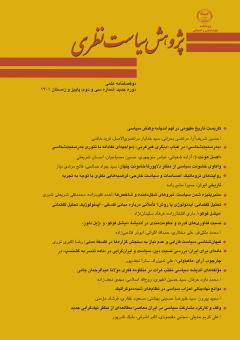واکاوی خشونت سیاسی از منظر دلاپورتا: خشونت پنهان
محورهای موضوعی : پژوهش سیاست نظری
سید جواد صالحی
1
,
فاتح مرادی نیاز
2
![]()
1 - استادیار گروه حقوق و علوم سیاسی، دانشگاه شیراز، ایران
2 - دانشآموخته کارشناسی ارشد مطالعات خاورمیانه و شمال آفریقا، دانشگاه شیراز، ایران
کلید واژه: نظریه خشونت, خشونت سیاسی, دلاپورتا, بنیادگرایی و نزاعهای قومی- مذهبی. ,
چکیده مقاله :
تحوّلات موسوم به بهار عربی که بسیاری از آن تعبیر به بهار و بیداری میکردند و وجه بارز آن را مطالبۀ آزادی و دموکراسی میدانستند، خیلی زود به خزان نشست. مسیر این روند منحرف و خشونت به وجه بارز آن مبدّل شد. گروههای بنیادگرایی چون داعش، رژیمهای دیکتاتوری، گروههای تندروی چون القاعده و گروههای شبه نظامی در عراق، سوریه و یمن، ابعاد تازهی از سبعیت و خشونت لجام گسیخته را به کمک ظرفیت رسانههای دیداری- شنیداری به نمایش گذاشتند. در حقیقت خشونت به شکل بیسابقهای به اهرم نمایش قدرت کنشگران مختلف مبدل شد. از این رو اهمیت این متغیر و نقشی که این عامل در تحولات اخیر خاورمیانه بر عهده دارد، نویسندگان را مجاب ساخت تا به بررسی علل و پیامدهای شکلگیری خشونت، به ویژه با انگیزههای سیاسی بپردازند. این هدف حول این پرسش شکل گرفت که ویژگیهای محوری خشونت سیاسی از دیدگاه دلاپورتا چیست. از این رو تلاش میشود تا با رویکردی تحلیلی- تبیینی و با استناد به آرای «دوناتلا دلاپورتا» در حوزۀ خشونت سیاسی و رجوع به منابع کتابخانهای و اینترنتی به واکاوی این پدیده در قالب فکری و گفتمانی پرداخته شود. فرضيه پژوهش بر اين اصل استوار است كه خشونت سیاسی و به طور ویژه خشونت پنهان، فرآیندی پیچیده و چندبُعدی است که سازوکارهای مختص خود را دارد. خشونت سیاسی پنهان در حقیقت برآیند تعامل و تقابل چندسویۀحاکمیت و گروههای اجتماعی و کنشگران با توجه به امکانات و ظرفیتهای موجود است.
Arab uprisings, interpreted by many as spring or awakening, failed in its core objectives of achieving freedom and democracy. The path to freedom by these nations soonwas highjacked and replaced by violence. This includes Islamic Fundamentalist groups such as ISIS and al-Qaeda, authoritarian regimes, and militant groups in Iraq, Syria and Yemen have displayed new dimensions of unbridled violence through the capacity of audio-visual media. In fact, violence has become an instrument for various political and military actors to represent their strength through it in these regions. Hence, the importance of this variable and the role it plays in recent developments in the countries as part of the Arab uprisings has led the authors to study the causes and consequences of the formation of violence, especially with political motives, around the question of what are the central characteristics of political violence from Dellaporta's point of view? Therefore, in this study an attempt is made to analyze this phenomenon in an intellectual and discourse format with an analytical-explanatory approach and by referring to Donatella Dellaporta's opinions in the field of political violence by referring to library and internet sources. The research hypothesis is based on the principle that political violence, especially hidden violence, is a complex and multidimensional process that has its own mechanisms. In fact, hidden political violence is the result of multi-faceted interaction and confrontation between the government and social groups and activists according to the available facilities and capacities.
آرنت، هانا (1359) درباره خشونت، ترجمه عزتالله فولادوند، تهران، خوارزمی.
-------- (1397) خشونت و اندیشههایی درباره سیاست و انقلاب، ترجمه عزت¬الله فولادوند، تهران، خوارزمی.
اشمیت، کارل (1388) مفهوم امر سیاست، در: قانون و خشونت، ترجمه صالح نجفی، تهران، غزال، صص 89- 155.
آگامبن، جورجو و کارل اشمیت و والتر بنیامین (1388) قانون و خشونت، ترجمه مراد فرهادپور، تهران، نشرنی.
دردریان سمیعی اصفهانی، علیرضا و جعفر نوروزی¬نژاد (2015) «دولت- ملتسازی بین¬المللی و خشونت سیاسی در عراق جدید»، پژوهش¬نامه ایرانی سیاست بین¬الملل،سال دوم، شماره3، صص 95-121.
روزنا، جیمز (1382) آشوب در سیاست جهان، ترجمه علیرضا طیب، تهران، روزنه.
ژیژک، اسلاوی (1389) خشونت (پنج نگاه زیرچشمی)، ترجمه علیرضا پاک¬نهاد، تهران، نشرنی.
سن، آمارتیا (1388) هویت و خشونت، ترجمه فریدون مجلسی، تهران، آشیان.
فکوهی، ناصر (1378) تاریخ خشونت سیاسی، تهران، قطره.
Arendt, H (1970) On violence, Houghton Mifflin Harcourt.
Burton, F. H (1975) Plurationalism And the Unmaking of Violence.
Cavanaugha, K. A (2007) Interpretations of political violence in ethnically divided societies, Terrorism and Political Violence, In Terrorism and Political Violence (Vol. 9, pp. 33-54) Routledge.
Della Porta, D (2006) Social movements, political violence, and the state, A comparative analysis of Italy and Germany, Cambridge University Press.
Della Porta, D., & Diani, M. (Eds.) (2015) The Oxford handbook of social movements. Oxford University Press.
Della Porta, D. d (1995) Social Movements, Political Violence, and the State, A Comparative Analysis of Italy and Germany, Cambridge University Press.
-------------------- (2008, July) Research on social movements and political violence, pp. 221-230.
-------------------- (2013) Clandestine political violence, Cambridge University Press. Elias, N. (1969) The civilizing process: The history of manners.
Kalyvas, S. N. (2003) The ontology of “political violence”: action and identity in civil wars. Perspectives on politics, 1(3), 475-494.
Gissy, W (2022) Political Economy of Violence.
Oxford Dictionary (2018) Violence, Retrived from: https://www.oxfordlearnersdictionaries.com/.
Sen, A (2007) Identity and violence, The illusion of destiny, Penguin Books India.
World Health Organization (2002) Violence, health and sustainable development, World Health Organization.


